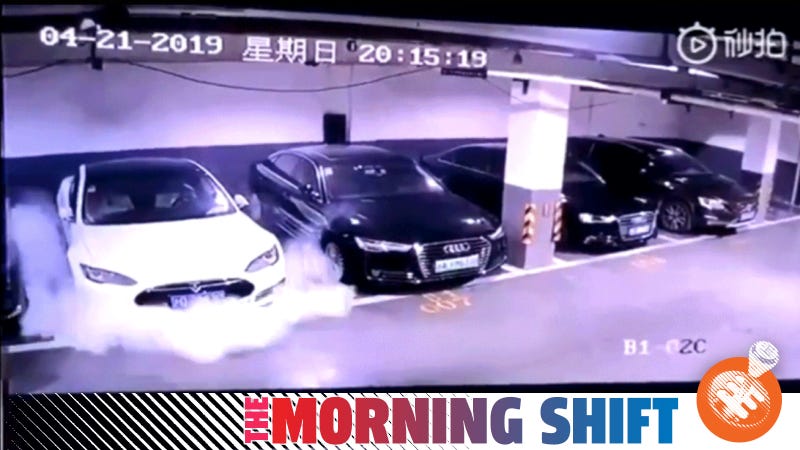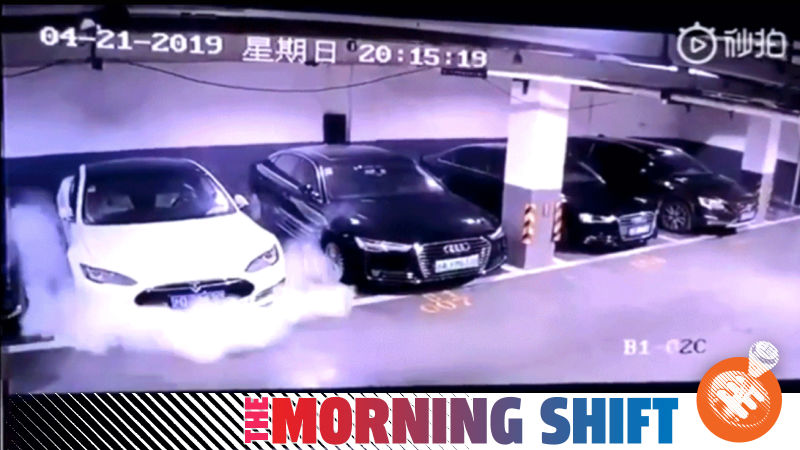
 The Morning ShiftAll your daily car news in one convenient place. Isn’t your time more important?
The Morning ShiftAll your daily car news in one convenient place. Isn’t your time more important? Fires have China cracking down on EVs, Ford is in the middle of an important connected-car discussion with the government, Volvo and NVIDIA are working on self driving trucks, FCA apparently can’t keep its suppliers happy, and more in The Morning Shift for Tuesday, June 18, 2019.
1st Gear: China is Cracking Down on Electric Vehicle Safety After Tesla and NIO Fires
China, the breeding ground for electric cars thanks to massive government incentives, has been having some EV conflagration issues lately. A Tesla Model S turned into a huge fireball in a Shanghai parking garage back in April, and a NIO electric vehicle went up in flames shortly thereafter in Xi’an. Later in May, another Tesla went up in flames in Hong Kong (a Special Administrative Region of China) and another NIO caught fire in Shanghai. Then, according to Quartz, another NIO charred itself in June in the city of Wuhan.
So it’s no surprise that China’s Ministry of Industry and Information Technology is now requiring automakers to conduct safety checks. From Bloomberg:
China is ordering carmakers to conduct checks on electric vehicles after cars made by Tesla Inc. and NIO Inc. caught on fire, spurring anxiety over the safety of battery-powered automobiles.
Companies need to check for potential safety hazards with battery boxes, waterproof protection in cars, high-voltage wiring harnesses, as well as on-board charging devices, the country’s industry and technology ministry said in a statement posted on its website. Automakers need to submit their findings by the end of October.
[…]
The Chinese ministry said safety checks should also be carried out on cars that have already been sold, with special attention paid to highly used vehicles such as cabs, according to the statement.
Advertisement
You can read the ministry’s full press release on the topic, which describes the inspection process a little more in detail, here. Reading the translated press release, it appears that the ministry discusses various “triggers” that would require an automaker to ask a user to bring a vehicle in for inspection. From the ministry:
The triggering conditions shall include: the normal mileage of the vehicle or the interval of use, the accident of the vehicle colliding, soaking water, etc., and the vehicle instrument has a serious fault alarm signal (such as battery, overvoltage, overtemperature, low insulation, overheating of the charging socket, etc.) )…When the production enterprise discovers that the vehicle has reached the above trigger condition through monitoring data, it should promptly remind the user to return to the store for inspection and maintenance by means of telephone, SMS, vehicle alarm, etc.
Advertisement
It’s worth noting that gasoline vehicles catch fire quite regularly, so there’s probably no need to freak out over electric cars, even if viral videos like the Tesla one look pretty scary.
2nd Gear: Ford Shows FCC Chairman New Connected-Car Tech Amid Controversial Discussions About Radio Frequency Bands
Back in October of 1999, the Federal Communications Commission set aside the 5.850-5.925 GHz frequency band of U.S. radio frequency spectrum for “Dedicated Short Range Communications,” or DSRC, which the FCC defines as “vehicle-to-vehicle and vehicle-to-infrastructure communications.”
Advertisement
The issue is that, with little vehicle-to-vehicle and vehicle-to-infrastructure communication actually taking place on U.S. roads today, cable companies are trying to get a hold of some of those precious 75 megahertz of spectrum in the 5.9 GHz band to use for Wi-Fi. From Bloomberg’s October, 2018 story:
NCTA-The Internet & Television Association, a trade group with members including top U.S. cable provider Comcast Corp., on Tuesday asked regulators to open those airwaves for use by Wi-Fi signals that will shoulder more and more of cable subscribers’ traffic.
“Use of this band has failed,” the NCTA said in a petition to the Federal Communications Commission. The U.S. “can no longer afford” to allocate those airwaves exclusively for vehicle-to-vehicle communications “with the hope that the next twenty years will somehow be different than the last two decades of stagnation,” the group said.
Advertisement
Today, Bloomberg writes about how Ford took FCC Chairman Ajit Pai on a ride in a new F-150 to demonstrate its new cellular V2X technology. Ford’s Executive Director of Connected Vehicle and Services Don Butler told Bloomberg earlier this year that the company was focusing on cellular instead of DSRC since it allows for faster deployment due to already existing cellular infrastructure.
Bloomberg’s latest story mentions Pai’s ride in Ford’s specially-equipped F-150, which was presumably a bid to convince regulators to green-light cellular, 5G-based V2X:
Executives of Ford Motor Co. gave Pai a ride in a specially outfitted F-150 pickup truck earlier this month. The idea was to demonstrate the technology that could, for example, warn of a scooter’s approach or judge when it’s safe to enter an intersection.
“Grateful to Ford for showing us a glimpse of the future,” Pai said in a tweetafter his parking-lot spin. “It’s important to have an open conversation about the future of this band” of airwaves.
Advertisement
Despite Ford’s push to cellular, some automakers are still fans of DSRC, so there doesn’t seem to be a consensus on this topic yet, as Bloomberg notes:
The government has spent hundreds of millions on competing Wi-Fi technology called dedicated short-range communications, or DSRC, which has been embraced by General Motors Co. and Toyota Motor Corp. Ford says it’s trying to accelerate adoption of C-V2X as the best solution for getting cars to talk to each other.
“Our hope is that this would spur others to potentially reassess and, in other cases, decide on this direction,” Don Butler, executive director of Ford’s connected-vehicle platform, said in an interview. “We’ve been looking at DSRC for a number of years along with Toyota, GM and Honda, so this is not a step that we take lightly in the sense of dismissing DSRC. But we think this is the right step to make given where we see the technology headed.”
Advertisement
For those trying to preserve the DSRC bands (this includes Ford, according to Bloomberg), time may be running out, as Pai has stated that he wants to re-open discussion about how the airwaves are being utilized:
“The spectrum, for 22 years, has not reached its highest valued use, and that’s part of the reason why I think it’s important to have an open conversation,” Pai said at a Senate hearing last week. “I’m not saying what the answer should be, I’m simply saying let’s ask the questions that would enable us to have an informed conversation.”
Advertisement
Who knew radio frequency bands could be this exciting?
3rd Gear: Speaking of Futuristic Car Tech, Volvo and NVIDIA are Teaming up for Self-Driving Trucks
U.S.-based computer chip company NVIDIA is teaming up with Volvo as the automaker plans to deploy self-driving trucks on public roads. From Automotive News:
Volvo, which demonstrated its first autonomous truck last year, said the partnership [with NVIDIA] would develop a flexible, scalable self-driving system, which is planned to be used first in pilot schemes before commercial deployment.
“The resulting system is designed to safely handle fully autonomous driving on public roads and highways,” Volvo said in a statement.
It’s just the latest automotive venture for NVIDIA, which, as Automotive News notes, has also teamed up with Toyota, Mercedes, and VW, and which offers “Drive Constellation chips,” that “often power the machine learning used to refine self-driving car software algorithms inside data centers.”
Advertisement
4th Gear: Fiat Chrysler Has a Problem Making its Suppliers Happy
In this year’s supplier relations rankings, which involves surveys from various automotive suppliers about what it’s been like dealing with various OEMs, Toyota and Honda are at the top and Fiat Chrysler is once again near the bottom, per the report from the consulting firm Plante Moran.
Advertisement
Electronics suppliers seem to be among those with the most complaints, as Automotive News writes:
“One of the biggest red flags was a downgrade in the area of electronics,” [Dave Andrea, principal of Plante Moran] said about the annual report card on automotive purchasing and relationships.
[…]
Andrea said the purchasing complaints reported by electronic component companies resulted from a combination of factors, including suppliers’ struggles to make a profit and reports of repeated auto maker engineering changes.
Advertisement
Fiat Chrysler told the news site it was “not at all satisfied” and that the feedback “will help us make the kind of transformational changes we’ve embarked on as a business.”
5th Gear: Bicyclists and Pedestrians Keep Dying
Overall traffic deaths are dropping, but pedestrian and bicyclist deaths are increasing according to a new NHTSA report. From Reuters:
U.S. pedestrian and bicyclist deaths rose in 2018 while overall traffic deaths fell 1% in 2018 to 36,750, the National Highway Traffic Safety Administration (NHTSA) said in a preliminary report Monday.
Advertisement
This is a change from 2017, when pedestrian deaths were down 1.7 percent and bicyclists deaths were down 8 percent. It’s not clear from the story what caused the jump in the latest NHTSA report, but Reuters does mention distracted driving, and how difficult it is to really understand its influence:
The agency has been investigating the role of distracted drivers in overall U.S. traffic death figures but has found challenges in getting an accurate picture of all distracted crashes because of the unwillingness of individuals to acknowledge they were distracted.
Advertisement
Reverse: The First Checker Cab Rolls Off the Line in Michigan
From History:
On June 18, 1923, the first Checker Cab rolls off the line at the Checker Cab Manufacturing Company in Kalamazoo, Michigan.
Morris Markin, founder of Checker Cab, was born in Smolensk, Russia, and began working when he was only 12 years old. At 19, he immigrated to the United States and moved to Chicago, where two uncles lived. After opening his own tailor’s shop, Markin also began running a fleet of cabs and an auto body shop, the Markin Auto Body Corporation, in Joliet, Illinois. In 1921, after loaning $15,000 to help a friend’s struggling car manufacturing business, the Commonwealth Motor Company, Markin absorbed Commonwealth into his own enterprise and completely halted the production of regular passenger cars in favor of taxis. The result was the Checker Cab Manufacturing Company, which took its name from a Chicago cab company that had hired Commonwealth to produce its vehicles.
Advertisement
Neutral: Does Electric Car Battery Safety Worry You?
Do the videos of EV fires have you concerned about EV safety?















